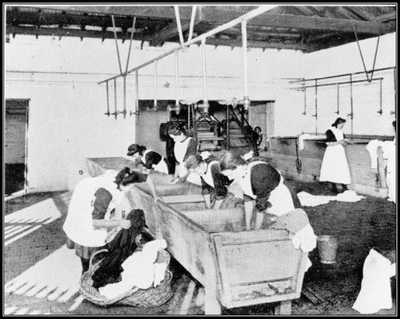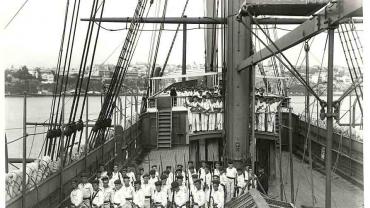A brief history of the Randwick Asylum for Destitute Children. A list of the main records series can be found in the Child Care and Protection Guide.
Historical Background
 On 4 June 1852, the Society for the Relief of Destitute Children opened Ormond House in Oxford Street, Paddington for the reception of needy children.
On 4 June 1852, the Society for the Relief of Destitute Children opened Ormond House in Oxford Street, Paddington for the reception of needy children.
The Society's aim was to care for abandoned children or those whose parents were 'dissolute characters'. Single parents could place children in Ormond House upon the payment of a fixed sum for the child's maintenance.
The children were normally between the ages of three and ten years and not eligible for admission to the Orphan Schools. While at Ormond House, they received an industrial training and religious instruction. In its first year 89 children were admitted, however, by 1856 the number had risen to 150.
Every child admitted (including voluntary admissions) was to remain the responsibility of the Institution until aged 19 or, in the case of a female marrying earlier, until her marriage. The Directors were authorised to apprentice the children from the ages of 12 to 19. The decision of two Justices of the Peace could require parents to make weekly contributions towards the support of the child. The Board could relinquish the care of a child to its parent if the parent could demonstrate capacity to care for and maintain the child.
An Act 'to incorporate and otherwise promote the objects of the Society for the Relief of Destitute Children' was assented to on 23 February 1857. Under this legislation, from 1 March 1857 the Society was constituted as a body politic and corporate with a common seal, having perpetual succession and being capable of purchasing and selling goods and property [1]. The passing of the Act enabled the Society to build larger premises. The Government granted 60 acres at High Cross, Randwick and a bequest of £11 000 from the Society's first medical officer meant that a building to accommodate 400 children could be constructed and the Randwick Asylum for Destitute Children was occupied on 28 March 1858.
The completion of a new wing in 1863 provided accommodation for a further 400 children. Following the death of 77 children from whooping cough in 1867, funds donated by the Irish singer Catherine Hayes in 1855 were used to build a hospital named after her.
The Asylum aimed to be self-sufficient from its inception. The Randwick site included a farm where the boys learnt farming skills. Many of the boys and girls became apprenticed to the Institution when they reached 12. The children received a basic education. From 1877 they received a State education from teachers from the Council of Education.
The State Children Relief Act, 1881 (Act 44 Vic. No. 24, 1881) which commenced on 5 April 1881 authorised any State child under the age of twelve to be removed from an Asylum and boarded-out. Boarding out commenced in 1883, and the number of resident children subsequently declined.
After 1888, the Government ceased funding the home and no longer used it as an accommodation for State children, although some children who were supported by their parents remained in the Asylum. The premises were increasingly under-utilised until it was taken over by the Federal Government during World War I as a military hospital for wounded and disabled returned servicemen.
In April 1915 the children remaining at the Asylum were sent to cottage style institutions or boarded-out. The property continued in use as a military and repatriation hospital until the 1950s. The Prince of Wales Hospital now occupies the site.
Two hundred and sixteen children died while they were inmates of the Asylum [2]. It appears that many were buried in the grounds. In the mid 1990s a project was undertaken to identify the site of these burials and during construction at the Prince of Wales Hospital, archaeologists retrieved the remains of 174 children who died and were buried on the site. Seventy bodies were excavated and 35 children identified by name. A memorial garden and commemorative signage giving the history of the Asylum, the names of the children who died there, and the details of the children whose remains were identified is located near the main entrance to the Hospital in Barker Street, Randwick [3].
Footnotes
[1] Destitute Children's Society Act of 1857 [20 Victoria, Act No. 19, 1857]
[2] Doyle, Frank and Storey, Joy. Destitute Children's Asylum Randwick 1852-1916. Randwick and District Historical Society, 1991, p. 19
[3] http://www.segd.org/awards/2001.html
Further reading
- Doyle, Frank and Storey, Joy, Destitute Children's Asylum Randwick 1852-1916, Randwick and District Historical Society, 1991.
- Smith, Beverley, comp., Randwick Destitute Children's Asylum: Deaths and Burials 1853-1916, N.S.W., Cape Banks Family History Society, Maroubra, 1995. This lists the children (216) who died while inmates of the Asylum.
- Coulter, J., Randwick Asylum: An Historical Review of the Society for the relief of Destitute Children, New South Wales Government Printer, Sydney, 1916.
- Godden Mackay Pty Ltd, Prince of Wales Project 1995 Randwick Asylum for Destitute Children Cemetery. Report prepared for the South-Eastern Area Health Service, Heritage Council of NSW and the NSW Department of Health, December 1997.
- Ramsland, J., Children of the Backlanes, New South Wales University Press, Kensington, 1986.
- Randwick Municipal Council, Randwick, A Social History. New South Wales University Press, Kensington, 1985.
- Rathbone, Ron, A very present help: Caring for Australians since 1813: The history of the Benevolent Society of New South Wales, State Library of NSW Press, Sydney, 1994.
- SEGD. Web site (online), URL: www.segd.org/awards/2001.html (cited November 2001).
ARCHIVES IN BRIEF
Content in the Guide first appeared in Archives in Brief 66 - Randwick Asylum for Destitute Children
What's happened with Archives in Brief »


